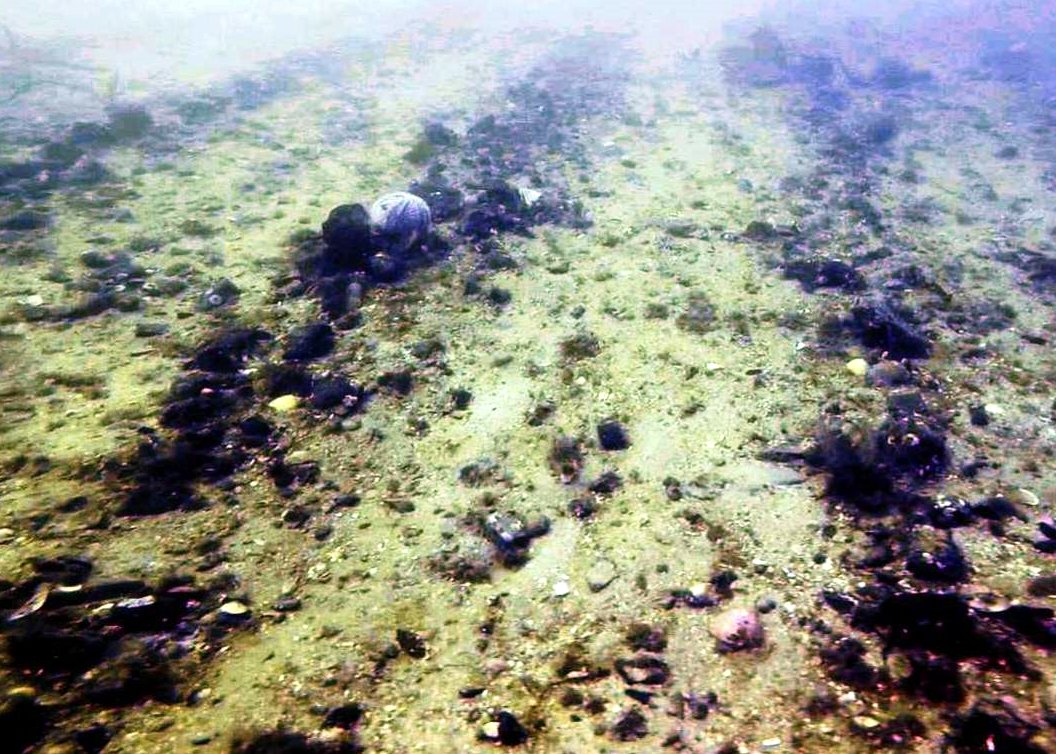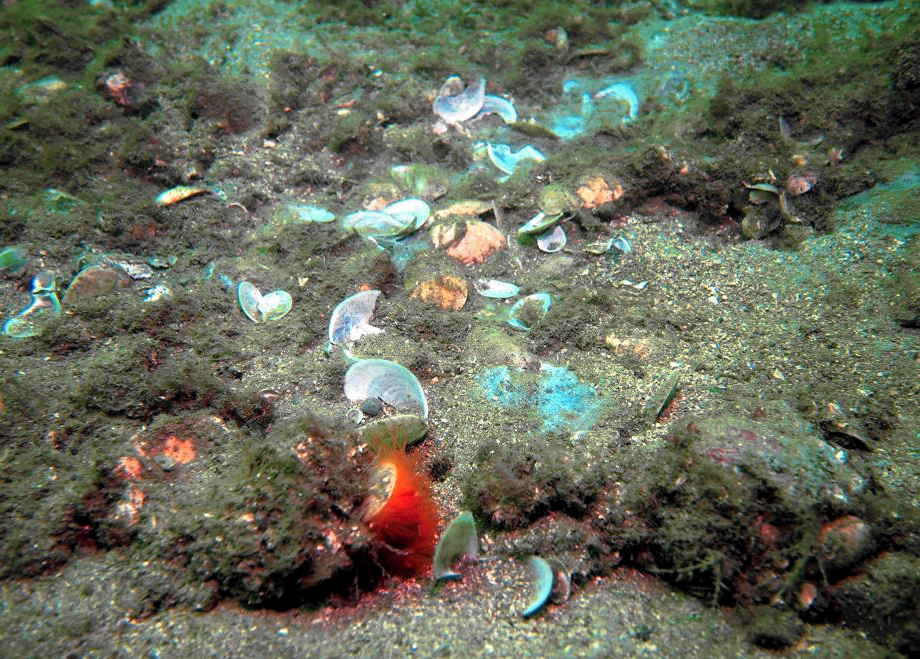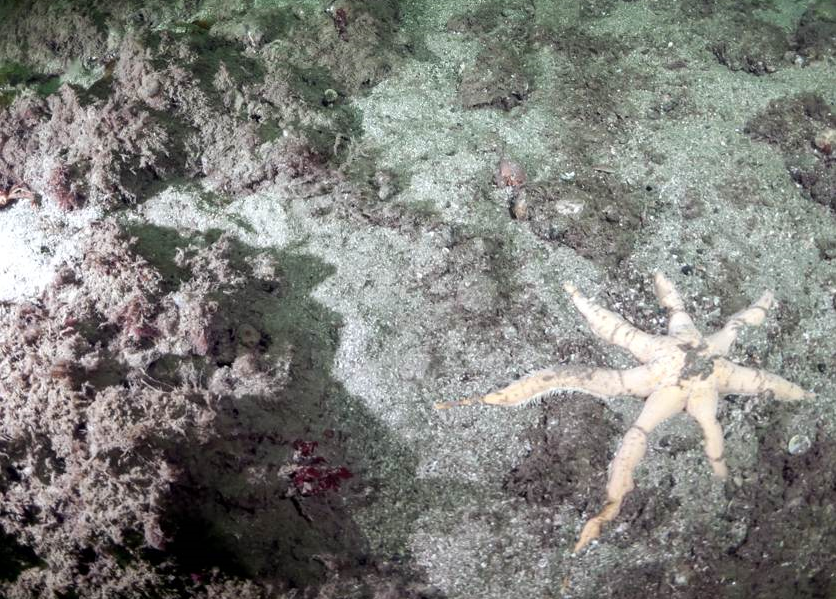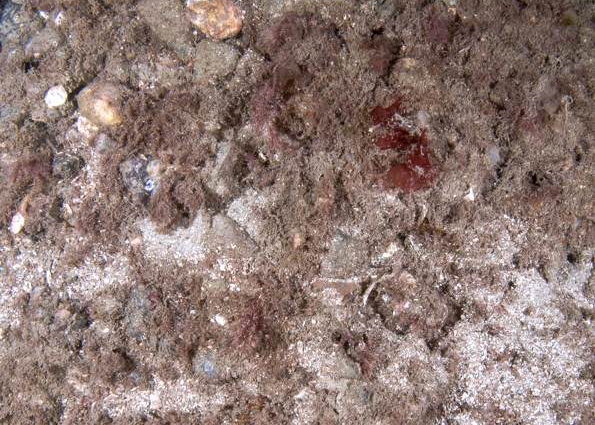This is one of two case study examples from nearshore waters produced to accompany the Predicted extent of physical disturbance to seafloor assessment which uses fisheries activity data to predict likely levels of disturbance to seabed habitats across Scottish waters. Persistent damage to serpulid reefs in Loch Creran (see Case study) from towed, bottom-contacting fishing activity is considered separately.
The flame shell Limaria hians is a 2 - 4 cm long bivalve mollusc, which constructs a nest of fine byssal threads (tough silky filaments secreted by the animal). In a few locations in Scottish waters dense populations develop (several hundred per square metre) with the nest material forming a spongy ‘turf’ covering several centimetres thick over much of the seabed, often incorporating stones and shells and providing a substrate for a rich associated community of benthic invertebrates and algae (Figure 1). The habitat is recognised as a Priority Marine Feature (see PMF case study for further details).
Following reports of damage to the flame shell bed habitat in Loch Carron by scallop dredging in 2017, a survey was carried out by Scottish Natural Heritage, Marine Scotland Science and Heriot-Watt University to confirm the presence of the damage and assess its nature and extent and to establish a programme for monitoring habitat recovery (Scottish Natural Heritage & Marine Scotland Science, 2017; Moore et al., 2018).
The 2017 survey work identified four flame shell beds in Loch Carron and confirmed the presence of damage consistent with dredging activity affecting two of the beds, with estimated degradation of 8% of one bed and 4% of the other.

Figure 1: Flame shell bed showing exposed flame shell with array of orange tentacles and byssal turf. The black holes in the turf (highlighted by yellow circles) are the apertures of galleries within which the flame shell population resides © NatureScot
The observed damage was patchy and varied in nature and intensity, with the severest impact resulting in the formation of distinct series of parallel dredge tracks or scars (Figure 2a), each of the order of 0.5 - 1.0 m wide, generally with narrow lines of stones and associated biota separated by broader bands of sandy sediment with relatively sparsely scattered stones.
In areas where the bed was better developed, physical destruction of the habitat was reduced and typically took the form of flattening (Figure 2d and 2e) and disaggregation (Figure 2f) of the byssal turf and stone matrix. The survey undertaken within a few weeks after the dredging found many broken shells of bivalve molluscs (including those of flame shells) (Figure 2b) and sea urchin tests, as well as bacterial mats (Figure 2c) associated with decomposition of recently dead benthic organisms, particularly flame shells.
The Loch Carron Marine Protected Area was established in May 2017 (initially as an emergency MPA) to afford protection for the flame shell bed habitat. The use of demersal dredges and trawls is now prohibited throughout that part of the loch supporting flame shell and maerl beds by The Loch Carron Marine Conservation Order 2019.
 (a)
|
 (b)
|
 (c)
|
 (d)
|
 (e)
|
 (f)
|
Figure 2: Range of dredge impacts on Loch Carron flame shell beds. (a) parallel dredge scars; (b) dead and broken shell material; (c) bacterial mats; (d) byssal turf flattening to the right of central pin; (e) byssal turf reduction and flattening; (f) byssal turf disaggregation. © NatureScot
The Loch Carron Marine Protected Area was established in May 2017 (initially on a time limited urgent basis) to afford protection for the flame shell bed habitat. The use of demersal dredges and trawls is now prohibited throughout that part of the loch supporting flame shell and maerl beds by The Loch Carron Marine Conservation Order 2019 (see Figure 3 for the Loch Carron MPA designation timeline).

The designation of Loch Carron MPA illustrates the responsive nature of government agency survey programmes and Marine Protected Area designation and management processes in Scotland. Evidence of dredging from 2017 was still visible during follow-up drop-down video survey work in 2019. At one of the survey stations close to the boundary of one of the outer beds, where the flame shell habitat was relatively poorly developed, this took the form of distinct parallel dredge tracks (Moore, 2020). Further survey work is anticipated in Loch Carron in 2021/22 to determine whether there has been any recolonization of the parallel lines of pebbles and cobbles by Limaria hians since 2017.
Scotland has an extensive and varied coastline comprising approximately 50% rocky and 50% sedimentary intertidal habitat. Large stretches of the Mainland west coast and Northern Isles are predominantly rocky whereas on the west coast of the Outer Hebrides and the Mainland east coast it is much more patchy with rocky shores and cliffs interspersed by large stretches of sandy and muddy coastline. Intertidal habitats are affected by numerous physical variables including wave exposure, salinity, temperature and tides which dictate what animals and plants are found on specific shores. The subtidal communities are strongly affected by factors such as the availability of light, wave action, tidal stream strength and salinity. Rocky shallow continental shelf habitats are typically dominated by seaweeds and in deeper areas below the photic zone (about 50 m) communities comprise exclusively animals. Shallow subtidal sediments in places support habitats such as seagrass beds and maerl, a red seaweed with a hard chalky skeleton that forms small twig-like nodules which accumulate to form loosely interlocking beds, creating the ideal habitat for a diverse community of organisms. Typically sedimentary habitats are dominated by a range of burrowing animal species.
The Biogenic habitats assessment catalogues the loss in extent of six biogenic habitats (all Priority Marine Features): blue mussel, horse mussel, flame shell, maerl, seagrass beds, and serpulid aggregations. The Predicted extent of physical disturbance to seafloor assessment uses the degree of exposure to demersal fishing activity as a proxy for habitat condition. The Intertidal seagrass assessment is a first attempt to understand the ecological health of Scottish intertidal seagrass and is restricted to six sites.
The Case study: Biogenic habitat enhancement highlights the efforts now being made to enhance the status of some biogenic habitats through activities aimed at aiding their recovery and restoration. In other cases, where damage to Priority Marine Features has occurred, positive action is taken as demonstrated in the Case study: Protecting the Loch Carron flame shell beds where emergency measures were put in place to prevent further damage and subsequently a Marine protected Area was designated. The fact the prevention is better than cure is illustrated by the Case study: Persistent damage to the Loch Creran serpulid reefs where damage that was first observed in 1998 still shows little evidence of recovery. The value of long-term monitoring of specific sites is illustrated by the Case study: Intertidal rock which highlights how looking at changes at a community scale helps separate natural variations on species abundances from longer term community trends. The growing awareness of natural capital and ecosystem services provided by the marine environment is illustrated by the three case studies Case study: Blue carbon in Scottish maerl beds; Case study: Blue carbon in Scottish marine sedimentary environments; Case study: Blue carbon: the contribution from seaweed detritus which highlight the importance of marine habitats in climate change mitigation through the capture and storage of blue carbon, and the need for the protection of such habitats from various anthropogenic activities. Despite a long history of intertidal and subtidal survey work there remains significant gaps in knowledge. The Case study: Seabed habitats in territorial waters - the evolving knowledge-base charts the ongoing surveys that have been undertaken by government agencies and citizen science initiatives to further expand and improve the knowledge base.
The seas around Scotland are home to a wide variety of animals and plants and are of international importance as a stronghold for many species. Whilst the protection of the wider environment through the management of various activities is essential, Marine Protected Areas (MPAs) have an equally important role to play in the protection and conservation of key habitats and species. There are now 230 MPAs covering 37% of Scotland’s marine environment (at December 2020, it was 22% in 2018 at the end of the assessment period) comprising MPAs for nature conservation (Nature Conservation MPAs; Special Areas of Conservation (SACs); Special Protection Areas (SPAs); Sites of Special Scientific Interest (SSSIs); and Ramsar sites), MPAs for other purposes (Demonstration and Research MPAs; and Historic MPAs), and Other Area-based Measures. Work continues to implement all the necessary management measures and the on-going monitoring necessary to determine the effectiveness of the protection afforded by the MPAs. The Case study: Protecting the Loch Carron flame shell beds documents the emergency measures put in place to prevent further damage after scallop dredgers destroyed part of the bed. In other cases, it is apparent that prevention is better than cure – the Case study: Persistent damage to the Loch Creran serpulid reefs where damage first recorded in 1998 still shows little evidence of recovery. The Case study: Flapper skate – Loch Sunart to the Sound of Jura MPA describes how the on-going monitoring involving recreational anglers has not only improved our understanding of the ecology but also the information necessary for determining the management measures needed to ensure their protection.
Perhaps one of the greatest challenges is balancing the need for protection and therefore control of certain activities with the resulting possible socio-economic impacts. The Case study: Socio-economic impacts of marine protected areas describes the outcomes of an initial assessment of the evidence and views of the impact of MPA designation. These are some initial findings from only 2-3 years after designation and whilst there is evidence in some areas that fishing has been made more challenging there are also early signs of positive environmental and community impacts. The lessons from other parts of the world is that to get a full and balanced picture of the effects of MPA designation takes time.


